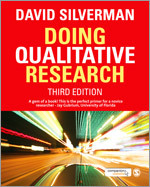I was reading Chapter 3 of David Silverberg’s Doing Qualitative Research: A Practical Handbook (Silverman, 2010 p.17-42) in September. In it he gives three research diaries of Ph.D. students he had, detailing how they went from the start of their research projects, through methodology choice, and then through to data analysis. While it was quite striking how coherent and “painless” the stories were, the more relevant realization I took away from it was the importance of having a framework around which to direct your research and to make sense of your data. In two of the cases, the students used conversational analysis, a ethnomethodological approach.
Conversation analysis (commonly abbreviated as CA) is the study of talk in interaction (both verbal and non-verbal in situations of everyday life). CA generally attempts to describe the orderliness, structure and sequential patterns of interaction, whether institutional (in school, a doctor’s surgery, court or elsewhere) or in casual conversation.
Wikipedia (2010a)
In my case, conversational analysis wouldn’t be appropriate, because it requires audio or video data of conversations and then a detailed transcription is made. The inductive data-driven analysis part to explain discovered patterns is a process I want to emulate, so I need a similar approach. That reminded me that some of James Paul Gee’s work used discourse analysis (or what I think is discourse analysis) and that might be an appropriate framework for me to use to structure my own research.
Unfortunately, I think standard discourse analysis isn’t quite correct. According to Wikipedia (2010b):
Discourse analysis (DA), or discourse studies, is a general term for a number of approaches to analyzing written, spoken, signed language use or any significant semiotic event.
The objects of discourse analysis—discourse, writing, talk, conversation, communicative event, etc.—are variously defined in terms of coherent sequences of sentences, propositions, speech acts or turns-at-talk. Contrary to much of traditional linguistics, discourse analysts not only study language use ‘beyond the sentence boundary’, but also prefer to analyze ‘naturally occurring’ language use, and not invented examples. This is known as corpus linguistics; text linguistics is related.
James Paul Gee’s use of discourse in social linguistics differentiates between “Discourse” (big Discourse) and “discourse” (little discourse). Discourse (big) is a combination of the language and its contextual environment, such as behaviour, values, perspectives, etc., so it’s a form of situated language analysis. He also looks at Discourse communities as part of that context. A seminal work in discourse analysis is Gee’s An Introduction to Discourse Analysis: Theory and Method (1999). I wonder if I should acquire this? I note a second edition was released in 2005. I’ve put in a request to the OU library to have their copy recalled and mailed to me.
References
Silverman, D. (2010) Doing Qualitative Research: A Practical Handbook, 3rd edition, London, United Kingdom, Sage Publications Ltd.
Wikipedia. (2010a) Conversation Analysis, [online] web page, Wikipedia. Available from: http://en.wikipedia.org/wiki/Conversation_analysis (Accessed September 15, 2010).
Wikipedia. (2010b) Discourse Analysis, [online] web page, Wikipedia. Available from: http://en.wikipedia.org/wiki/Discourse (Accessed September 15, 2010).








